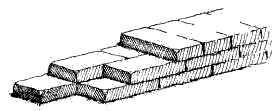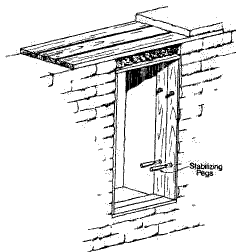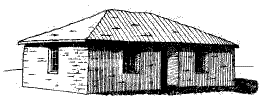
NEBRASKA STATE HISTORICAL SOCIETY
THE SOD HOUSE

NEBRASKA STATE HISTORICAL SOCIETY
THE SOD HOUSE
When the settler first arrived, his primary concern was to provide shelter for his family. When the terrain allowed, the dugout was the most practical solution. Building into a hill was advantageous for the settler because it was less work and effort than building another type of home. A ravine or a hill was selected, preferably facing south or east, away from the prevailing winter winds. The excavation was then covered with a roofing of logs, brush, and prairie sod. Sod bricks were laid up around the wooden door and window frames to form the front wall of the shelter. The dugout blended into its surroundings, and often the only sign of habitation was a stove pipe sticking up over the hill. Occasionally in the darkness, a wagon might rumble over the dugout, knocking dirt into the room below, or even crashing through the ceiling.
When able to do so, the family built a sod house, which was a more substantial home than the dugout. With a "grasshopper" plow, they plowed about one acre of ground into strips twelve inches wide and four inches thick. The strips were then cut into about three-foot lengths. In laying the sod bricks, the builder placed them lengthwise, making a wall two feet in depth. The process was reversed every few layers, and the bricks were laid alternately lengthwise and crosswise to bind the walls, and to make them solid. All sod was laid with the grass side down. (See figure 1.)
Wooden door frames were set in place as the wall construction began. Window frames of wood were positioned when the wall reached the proper height. Sod was laid around the sides and on top of boards placed above the frame. A gap, left at the top, above the frame, was filled with rags or grass, which allowed the sod to settle without crushing the glass panes in the window. Pegs, driven into the sod through holes in the frames, held them in place. (See figure 2.)
Construction of the side walls varied little from house to house. The roof, however, allowed the builder a wide range of choices. The gable roof, hip roof, and shed roof were commonly used. Of these types, the gable roof was the most popular. (See figures 3, 4, and 5.)
A variety of materials was used, depending on the locality and the finances of the builder. Cedar logs, when available, were used as ridge poles because they were rot-resistant and strong. The ridge pole sometimes needed extra support, and this was commonly provided by, placing a forked post under each end, inside the walls. This provided the added advantage of having a place to put in pegs or hooks for hanging up clothes and utensils. (See figure 6.) Occasionally the forked supporting posts were placed just outside of the walls.
Willow, cedar, or other woods were used for rafters. Crude roofs were often constructed by spreading native wild plum or chokecherry brush, or similar growth over the rafters. This layer of brush was then covered with wild prairie grass and a layer of sod was added on top of the grass. (See figure 7.) This type of roof always leaked when it rained. White muslin or canvas was often tacked to the ceiling to catch dirt, mice, bugs, and other vermin which might enter through the ceiling. A twice-a-year washing of the ceiling cloth was customary.
Windows were generally set even with the outside wall. Twelve-pane, doublehung windows were commonly used. The area on the sides of the windows, beveled to allow more light to enter, was white-washed in an attempt to control the dirt which was constantly flaking off into the room. The thick wall beneath the window provided a ledge (or sill), which often held colorful plants growing in tin cans. During a hard rain, these ledges were sometimes occupied by family members, since this was often the only dry spot in the house. (See figure 8.)
Curtains were sometimes hung at the windows. When a family could not afford glass windows or when they were not available, buffalo robes, blankets, or oiled paper were used.
Dirt floors were found in the majority of the early homes. A family which could afford them might fasten carpets to the dirt floor. In some cases, rough or planed split logs were used for flooring, but only a few could affort the luxury of wide, roughcut planks from the sawmill. After the initial planing, these boards became polished to a hard finish through daily wear and through scrubbing. Boards made of cottonwood soon warped, giving an uneven surface, and when completely dry the boards shrank and wide gaps appeared between them.
Warm in the winter and cool in the summer, a soddy provided adequate though not luxurious shelter for the settler and his family. The women particularly protested against the continual war with dirt, bugs, snakes, leaky roofs and poor lighting. Nothing ever seemed to be clean. Sod structures were able to defy Nebraska winds and storms for an average life of six or seven years. By then families were usually in a better position financially and able to build frame structures.
The settlers on the prairie overcame the problem of a limited fuel supply by burning buffalo or cow chips - the dung of animals. Some women rejected their use entirely. When chips were scarce, substitutes such as woody plants and hay were compressed mechanically or hand-twisted into faggots. An 1871 newspaper claimed an acre of woody plants such as sunflowers when compressed would produce twelve cords, and would furnish enough fuel for the winter. The most universally used fuel was heavy slough grass, which was processed by simple presses advertised as labor savers.
Several types of stoves for burning hay were placed on the market. One type used two cylinders, called magazines, which were filled with weeds, hay or straw, and were fitted into place under the oven where the cylinders opened directly into the firebox. Spare magazines were kept filled. This type of stove was unsatisfactory, required constant attention, and was a great fire hazard when the cylinders were changed. Corn stalks were also used as fuel, and at times during the 1890s, it was cheaper to burn ears of corn as fuel than to sell it at low market prices.
Furniture usually was simple - even primitive - and sparse, though the settler might have brought a few valued pieces from the East. A table, a trunk, chairs, cupboards made of stacked boxes, bedsteads and a stove might comprise the furnishings. Occasionally there was a fancy clock, but settlers soon found that time had little meaning on the prairies. Most homes had at least one rocker, and the mother probably sat there while she knitted mittens, stockings, and scarves for her family. Stools, made by splitting dry logs and hewing and planing the rough edges, were a common substitute for chairs. Some homes had a wash stand with a porcelain pitcher and bowl on it. Often near the wash bowl was a bar of homemade soap and hanging nearby a towel - sometimes of the "roller" variety.
During the first years, very few settlers brought bedsteads with them from their former homes. Metal spring beds were almost unknown in earliest days, but rope beds were common. Ropes were laced between side boards to make crude springs, upon which was laid a mattress, filled with corn husks or straw. Bunks also were constructed, using forked poles and slats driven into the sod walls. Patchwork quilts and woven coverlets, often made by the settlers before they left the East, were spread over the beds. In the extreme cold of winter, feather beds and heavy robes, sometimes buffalo robes, were added. Settlers who had tools, and some knowledge of carpentry, were able to construct pieces of furniture for their homes from available bits of lumber. Clothing was often stored in the drawers of chests, or was hung on pegs on the wall. Linens usually were folded and placed in trunks.
Sometimes a framed painting or family portrait, brought from the East, or a wreath made of seeds, beads, yarn, or locks of hair from each member of the family, added a decorative touch to the dirt walls. Occasionally a family brought an organ or a melodeon from their former home. The possession of such an instrument brought neighbors to the home from the surrounding countryside, frequently for religious services on Sunday. In most instances, few books were owned by a settler. Most "libraries" consisted of a few books, a picture album, an almanac, and the Bible.
Although the era of living in such homes came to an end in the 1890s, sod houses still exist, and a few in Nebraska with many improvements are still occupied.
SELECTED REFERENCES
Butcher, S. D., Sod Houses Kearney: Western Plains Company, 1904.
Condra, Olson, and Knapp, The Nebraska Story, Lincoln: The University Publishing Company, 1951.
Dick, Everett, Sod House Frontier New York: Appleton-Century Company, 1937.
Huff, Alta Maxwell, and Louise Fowler Roote, editors, My Folks Came in a Covered Wagon, Topeka, Kan.: Stauffer Publications, Inc., Capper's Books, 1956.
Nebraska Pioneer Reminiscences, Cedar Rapids: Torch Press, 1916.
Welsch, Roger L., "The Nebraska Soddy" in Nebraska History Vol. 48, #4, Winter 1967.
Free land had been a political issue in the United States since Thomas Jefferson, to promote settlement of the West, advocated the doctrine of giving small farms to actual settlers. Thomas J. Benton promoted this doctrine in the 1830s, and later Horace Greeley, Andrew Jackson, and many others espoused the cause.
After 1852, in each session of Congress, homestead bills were introduced, but failed to gain approval. Opposition came from several sources. Southerners opposed the bill mainly because they were afraid it would result in filling the territories with anti-slavery settlers. Others disapproved because it would deprive the Federal Government of a valuable source of revenue. However, in 1860 a homestead bill, supported by Representative Galusha A. Grow, passed both houses of Congress, but was vetoed by President James Buchanan. In 1862 the bill was passed again, and President Abraham Lincoln signed it into law. This measure, due to the profound influence it exerted on the settlement of the West, had been ranked among the most important legislation in the nation's history.
This bill, as passed, provided that any citizen, or any alien who had declared his intention of becoming a citizen, who was over 21 years of age, or who was the head of a family, might file on 160 acres of public land. He could acquire title to it after living on it for five years, and after completing certain requirements, such as having it for his legal residence and making specified improvements.
Through an unusual combination of circumstances, Daniel Freeman of Illinois obtained the first homestead in the United States. The accounts of the circumstances surrounding Daniel Freeman's filing the first application for a homestead under the act of 1862 vary considerably in detail, but the essential facts seem to be as follows.
In 1862 Freeman, on secret duty with the Army, was headquartered at Fort Leavenworth. While on leave he chose a piece of land on Cub Creek about four miles north of Beatrice, Nebraska, and made a squatter's claim to it. He planned to make his filing when the Homestead Act went into effect January 1, 1863. On December 31, 1862, while on a military detail in Brownville (site of a United States land office) and under orders to proceed to St. Louis, he learned that the land office would not be open January 1 because of its observance as a holiday. Freeman, fearing he would lose the opportunity to file his claim, sought out the registrar of the land office and presented his case. He asked that he be permitted to file shortly after midnight. The registrar was sympathetic, and at the appointed time they went to the land office. There the necessary papers were made out, and Daniel Freeman became the future owner of the first free homestead in the United States. At the end of his military
Born on April 26, 1826, in Preble County, Ohio, Daniel Freeman moved with his parents to Abingdon, Knox County, Illinois, in 1835. Here he was reared and educated in public schools. In 1847 he began the study of medicine at Peoria, Ill., and in 1849 he graduated from the Eclectic Medical Institute in Cincinnati, Ohio. He began his medical practice at Ottawa, Ill. Although his practice was considered successful, when the Civil War began in 1861, Freeman enlisted in the 17th Illinois Volunteer Infantry. Soon after his enlistment he was transferred to the secret services where he served until the end of the war.
Daniel Freeman was married twice, first to Elizabeth Wilber, who died in 1861, leaving three children, and second, to Agnes Suiter of Scott County, Iowa, in 1865. To this union eight children were born. Agnes Freeman lived on the homestead for almost 60 years, until shortly before her death in 1931.
Freeman built a log cabin on his homestead when he returned from the war in 1865. He maintained his home on the claim until his death in 1908. He acquired a considerable amount of land in addition to the original homestead, and was a highly respected and influential citizen, active in the civic life of his community.
Congress, after some years of agitation, in 1936 provided for the purchase of the land comprising the original Freeman homestead from his heirs, and in 1939 the site became the Homestead National Monument of America with Nebraska Senator George W. Norris one of its Congressional sponsors.
Dictionary of American History III, pp. 41-43.
Dobbs, Hugh J., History of Gage County, Nebraska (Lincoln, 1918).
DuBois, James T. and Gertrude S. Mathews, Galusha A. Grow: Father of the Home stead Act (Boston: Houghton Miflin, 1917).
King, B. Palmer, "Land Policy: The Background of the Federal Reclamation Act," Reclamation Era April, 1942, pp. 74-75
Portrait and Biographical Album of Gage County, Nebraska (Chicago, 1888).
Sheldon, A. E., Land Systems and Land Policies in Nebraska, NSHS Pub. 22 (1936).

Figure 1 Sod house wall construction. Blocks were laid with grass side down.
|
|

Figure 2
|
|

|
6

|
|

Figure 5 |
 Figure 6
Figure 6
Forked poles sometimes were used to help support the heavy ridge poles.
 Figure
7
Figure
7
Shown is a type of crude roof construction very similar to the covering on an Indian earth lodge. This construction was used when better materials were not available or when the builder could not afford cut lumber, shingles, and tar paper. Common materials used in this "made from the land" roof were ridge poles of cedar or cottonwood, rafters of willow, cedar, or other wood, brush from wild plum and chokecherry, prairie grass atop the brush and sod over the prairie grass.
 Figure 8
Figure 8
Viewing window from inside soddie.